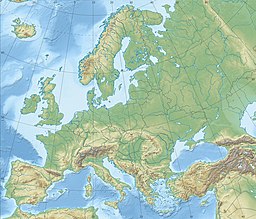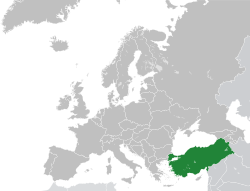Bosporus
| Bosporus Strait | |
|---|---|
| İstanbul Boğazı(Turkish) | |
| Coordinates | 41°07′10″N29°04′31″E/ 41.11944°N 29.07528°E |
| Type | Strait |
| Part of | Turkish Straits |
| Basincountries | Turkey |
| Max. length | 31 km (19 mi) |
| Min. width | 700 m (2,300 ft) |
| Max. depth | 110 m (360 ft) |
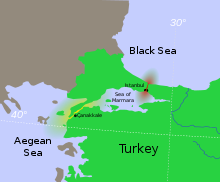


TheBosporusorBosphorus Strait(/ˈbɒspərəs,ˈbɒsfərəs/BOSS-pər-əs,BOSS-fər-əs;[a]Turkish:İstanbul Boğazı,lit. 'Istanbul strait', colloquiallyBoğaz) is a naturalstraitand an internationally significant waterway located inIstanbul,Turkey.The Bosporus connects theBlack Seato theSea of Marmaraand forms one of the continentalboundaries between Asia and Europe.It also divides Turkey by separatingAsia minorfromThrace.It is the world's narrowest strait used forinternational navigation.
Most of the shores of the Bosporus Strait, except for the area to the north, are heavily settled, with the city ofIstanbul'smetropolitanpopulation of 17 million inhabitants extending inland from both banks.
The Bosporus Strait and theDardanellesStrait at the opposite end of the Sea of Marmara are together known as theTurkish Straits.
Sections of the shore of the Bosporus in Istanbul have been reinforced with concrete or rubble and those sections of the Strait prone todepositionare periodically dredged.
Name
[edit]The name of the strait comes from theAncient GreekΒόσπορος(Bósporos), which was folk-etymologised asβοὸς πόρος,i.e. "cattle strait" (or "Ox-ford"[b]), from the genitive ofboûsβοῦς'ox, cattle' +porosπόρος'passage', thus meaning 'cattle-passage', or 'cow passage'.[7]This is a reference to theGreek mythological storyofIo,who was transformed into a cow and condemned to wander the Earth until she crossed the Bosporus, where she met theTitanPrometheus,who comforted her by telling her that she would be restored to human form byZeusand become the ancestor of the greatest of all heroes,Heracles(Hercules).
Iosupposedly went ashore nearChrysopolis(present-dayÜsküdar), which was namedBous'the Cow'. The same site was also known asDamalis(Δάμαλις), as it was where the Athenian generalChareshad erected a monument to his wife Damalis, which included a colossal statue of a cow (the nameδαμάλιςtranslating to 'heifer').[8]
The English spelling with-ph-(Bosphor) is not justified by the ancient Greek name, and dictionaries prefer the spelling with-p-.[a]However-ph-occurs as a variant inmedieval Latin(asBosphor,and occasionallyBosphorusorBospherus), and inmedieval Greeksometimes asΒόσφορος,[9]giving rise to the FrenchBosphore,the SpanishBósforo,the ItalianBosforoand the RussianБосфор.The 12th-century Greek scholarJohn Tzetzescalls itDamaliten Bosporon(afterDamalis), but he also reports that in popular usage the strait was known asProsphorionduring his day,[10]the name ofthe most ancient northern harbourofConstantinople.In English, the preferred spelling tends to be Bosphorus.
Historically, the Bosporus was also known as the "Strait of Constantinople", or theThracianBosporus to distinguish it from theCimmerian BosporusinCrimea.These are expressed inHerodotus'sHistories,4.83; asBosporus Thracius,Bosporus Thraciae,andΒόσπορος Θρᾴκιος(Bósporos Thráikios), respectively. Other names used by Herodotus to refer to the strait includeChalcedonianBosporus (Bosporus Chalcedoniae,Βόσπορος τῆς Χαλκηδονίης[Bosporos tes Khalkedonies], Herodotus 4.87), orMysianBosporus (Bosporus Mysius).[11]
The term eventually came to be used as the common nounβόσπορος,meaning "a strait", and was also formerly applied to theHellespontinClassical GreekbyAeschylusandSophocles.
Geography
[edit]As a maritime waterway, the Bosporus connects the Black Sea to the Sea of Marmara and thence to the Aegean and Mediterranean seas via the Dardanelles. It also connects various seas along theEastern Mediterranean,theBalkans,theNear East,andWestern Eurasia.Thus, the Bosporus allows maritime connections from the Black Sea all the way to the Mediterranean Sea and the Atlantic Ocean via Gibraltar, and to the Indian Ocean through theSuez Canal,making it a crucial international waterway, in particular for the passage of goods coming fromRussia.
There is one very small island in the Bosporus just off Kuruçeşme. Now generally known asGalatasaray Island(Galatasaray Adası),this was given to the Armenian architectSarkis Balyanby SultanAbdülhamid IIin 1880. The house he built on it was later demolished. The island became a walled garden and then a water sports centre, before it was given to theGalatasaray Sports Club,hence its name.[12]However, in the 2010s it was completely overbuilt with nightclubs. In another change, the government had these torn down in 2017. It reopened to the public in the summer of 2022.[13]
Formation
[edit]The exact cause and date of the formation of the Bosporus remain a subject of debate among geologists. One recent hypothesis, dubbed theBlack Sea deluge hypothesis,which was launched by a study of the same name in 1997 by two scientists fromColumbia University,postulates that the Bosporus was flooded around 5600 BCE (revised to 6800 BCE in 2003) when the rising waters of the Mediterranean Sea and the Sea of Marmara broke through to the Black Sea, which at the time, according to the hypothesis, was a low-lying body of fresh water.[citation needed]
Many geologists,[who?]however, claim that the strait is much older, even if relatively young on a geologic timescale.[14]
Present morphology
[edit]The limits of the Bosporus are defined as the line connecting the lighthouses ofRumeli FeneriandAnadolu Feneriin the north, and between theAhırkapı Feneriand theKadıköy İnciburnu Feneriin the south ( "Fener" is Turkish for lighthouse). Between these limits, the strait is 31 km (17 nmi) long, with a width of 3,329 m (1.798 nmi) at the northern entrance and 2,826 m (1.526 nmi) at the southern entrance. Its maximum width is 3,420 m (1.85 nmi) between Umuryeri and Büyükdere Limanı, and minimum width is 700 m (0.38 nmi) betweenKandilli PointandAşiyan.
The depth of the Bosporus varies from 13 to 110 m (43 to 361 ft) in midstream with an average of 65 m (213 ft). The deepest point is between Kandilli andBebek,at 110 m (360 ft). The shallowest locations are off Kadıköy İnciburnu at 18 m (59 ft) and off Aşiyan Point at 13 m (43 ft).[15]
The southbound flow of water is 16 000 m3/s (fresh water at the surface) and the northbound flow is 11 000 m3/s (salt water near the bottom).[16]Dan Parsons and researchers at theUniversity of LeedsSchool of Earth and Environment describe aBlack Sea undersea river.
TheGolden Hornis anestuaryoff the main strait that historically acted as a moat to protect Constantinople from attack, as well as providing sheltered anchorage for the imperial navies of various empires until the 19th century, after which it became a historic neighbourhood at the heart of Istanbul.
Newer explorations
[edit]Before the 20th century it was already known that the Black Sea and the Sea of Marmara flow into each other in a geographic example of "density flow". Then in August 2010, a continuous 'underwater channel' ofsuspensioncomposition was discovered flowing along the floor of the Bosporus, which would be the sixth largest river on Earth if it were on land.[17]The 2010 team of scientists, led by theUniversity of Leeds,used a robotic "yellow submarine" to observe detailed flows within this "undersea river", scientifically referred to as asubmarine channel,[17]for the first time. Submarine channels are similar to land rivers, but they are formed by density currents—underwater flow mixtures of sand, mud and water that are denser than sea water and so sink and flow along the bottom. These channels are the main transport pathway for sediments to the deep sea where they form sedimentary deposits.[17]
The team studied the detailed flow within these channels and its findings included that:
The channel complex and the density flow provide the ideal natural laboratory for investigating and detailing the structure of the flow field through the channel. Our initial findings show that the flow in these channels is quite different to the flow in river channels on land. Specifically, as flow moves around a bend it spirals in the opposite direction in the deep sea compared to the spiral found in river channels on land. This is important in understanding the sedimentology and layers of sediment deposited by these systems.[18]
The central tenet of theBlack Sea deluge hypothesisis that as the ocean rose 72.5 metres (238 ft) at the end of the last Ice Age when the massive ice sheets melted, the sealed Bosporus was overwhelmed by a spectacular flood that increased the then fresh water Black Sea Lake by 50%, and drove people back from the shores for many months. This hypothesis was supported by the findings of undersea explorerRobert Ballard,who discovered settlements along the old shoreline; scientists dated thefloodto 7500 BP or 5500 BC from fresh-salt water microflora. Driven out by the rapidly rising water, which must have been terrifying and inexplicable, people spread to all corners of the Western world carrying the story of a major flood. As the waters surged, they scoured a network of sea-floor channels less resistant to denser suspended solids in liquid, which remains a very active layer today.
The first images of these submarine channels showing them to be of great size,[19]were obtained in 1999 during aNATOSACLANT Undersea Researchproject using jointly the NATO RVAlliance,and theTurkish Navysurvey shipÇubuklu.In 2002, a survey carried out on board the Ifremer RVLe Suroitfor BlaSON project (Lericolais, et al., 2003[20]) completed the multibeam mapping of this underwater channel fan-delta. A complete map was published in 2009[21]using these previous results together with high quality mapping obtained in 2006 (by researchers atMemorial University of Newfoundlandwho were project partners in the study).
The project was led by Jeff Peakall and Daniel Parsons at theUniversity of Leeds,in collaboration with theUniversity of Southampton,Memorial University of Newfoundland,and theInstitute of Marine Sciences.The survey was run and coordinated from the Institute of Marine Sciences research ship, theR/VKoca Piri Reis.
Villages
[edit]The shores of the Bosporus were once lined with small fishing villages that had grown up since Byzantine times but really came into their own in the 19th century. Until the early 20th century most were only accessible by boat (known as caiques) along the Bosporus since there were no coast roads. Today the villages are no more than suburbs of Greater Istanbul but many retain the memory of their original village status in the suffix '-köy (village' to their names. e.g.Ortaköy,Yeniköy,Arnavutköy,Çengelköyand Vaniköy. These villages often had distinct identities associated with agriculture: Arnavutköy, for example, was associated with strawberry-growing while Çengelköy was famous for its sweet cucumbers.
Human history
[edit]As part of the only passage between the Black Sea and the Mediterranean, the Bosporus has always been of great importance from a commercial and military point of view, and it remains strategically important today. It is a major sea access route for numerous countries, includingRussiaandUkraine.Control over it has been an objective of a number of conflicts in modern history, notably theRusso-Turkish War (1877–78),as well as of the attack of theAllied Powerson theDardanellesduring the 1915Battle of Gallipoliin the course ofWorld War I.In 2022 during the Russian invasion of Ukraine the Bosporus' importance as a route by which grain reached the world was thrown into sharp profile.[22]
Ancient Greek, Persian, Roman and Byzantine eras (pre-1453)
[edit]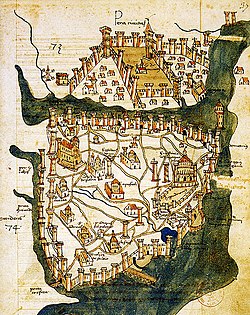
The strategic importance of the Bosporus dates back millennia. In the 5th century BC the Greek city-state ofAthens,which depended on grain imports from the Black Sea ports ofScythia,maintained critical alliances with cities which controlled the straits, such as theMegariancolonyof Byzantium.
In an attempt to subdue theScythianhorsemen who roamed across the north of the Black Sea, the Persian KingDarius Ithe Great (r. 522 BC – 486 BC) crossed the Bosporus, then marched towards theRiver Danube.His army crossed the Bosporus using an enormous bridge made by connecting boats.[23]This bridge essentially connected the farthest geographic tip of Asia to Europe, encompassing at least some 1,000 metres of open.[24]Years later,Xerxes Iwould construct a similarboat bridgeacross theDardanelles(Hellespont) strait (480 BC), during hisinvasion of Greece.
TheByzantinescalled the Bosporus "Stenon" and used the following major toponyms in the area:[25]
- on the European side:
- Bosporios Akra
- Argyropolis
- St. Mamas
- St. Phokas
- Hestiai or Michaelion
- Phoneus
- Anaplous or Sosthenion
- on the Asian side:
- Hieron tower
- Eirenaion
- Anthemiou
- Sophianai
- Bithynian Chrysopolis
The strategic significance of the Strait was one of the factors in the decision of the Roman EmperorConstantinethe Great to found his new capital,Constantinople,there in AD 330. This then became the capital of theEastern Roman Empire.
Ottoman era (1453–1922)
[edit]
On 29 May 1453, the then-emergentOttoman Empireconqueredthe city ofConstantinoplefollowing a lengthy campaign during which the Ottomans constructed fortifications on each side of the strait, theAnadoluhisarı(Anatolian Castle, 1393) and theRumelihisarı(European Castle, 1451), in preparation for not only the primary battle but to assert long-term control over the Bosporus and surrounding waterways. The final 53-day campaign, which resulted in Ottoman victory, constituted an important turn in world history. Together withChristopher Columbus's first voyage to the Americas in 1492, the1453 conquest of Constantinopleis commonly noted as amongthe events that brought an end to the Middle Agesand marked the transition to theRenaissanceand theAge of Discovery.
The event also marked the end of theByzantines—the final remnants of theRoman Empire—and the transfer of the control of the Bosporus into Ottoman hands. The Ottomans then made Constantinople their new capital, and the base from which they expanded their empire in the centuries that followed.
At its peak between the 16th and 18th centuries, the Ottoman Empire was able to use the strategic importance of the Bosporus to wrest control of the entireBlack Seaarea, which they regarded as an "Ottoman lake", from which Russian warships were prohibited.[27]
Subsequently, several international treaties have governed access to the Strait. Under theTreaty of Hünkâr İskelesiof 8 July 1833, the Bosporus andDardanellesstraits were to be closed to the naval vessels of other powers on Russian demand.[28]By the terms of theLondon Straits Convention,concluded on 13 July 1841 between theGreat PowersofEurope(Russia,theUnited Kingdom,France,AustriaandPrussia), the "ancient rule" of theOttoman Empirewas re-established by closing the Turkish Straits to allwarships,barring those of theSultan's allies during wartime. This benefitedBritish navalpower at the expense of the Russians, as the latter then lacked direct access to the Mediterranean.[29]
Summer Embassies
[edit]During the 19th century many of the foreign powers represented in Constantinople maintained second embassies up the Bosporus and would relocate their staff there during the hot, humid summer months. Most of these summer embassies were on the European shore atYeniköy(Austrian),Tarabya(German, English, French, Italian) andBüyükdere(Spanish, Russian). Some of the buildings still survive today although the British Summer Embassy burnt down in 1911 and the Italian Summer Embassy, a fine building byRaimondo d'Aronco,survives in very dilapidated condition.[30]
Turkish republican era (1923–present)
[edit]Following theFirst World War,the 1920Treaty of Sèvresdemilitarised the Strait and made it an international territory under the control of theLeague of Nations.This was amended by theTreaty of Lausanne (1923),which restored the straits to Turkey but allowed all foreign warships and commercial shipping to traverse the straits freely. Turkey eventually rejected the terms of that treaty, and remilitarised the straits area. The reversion was formalised under theMontreux Convention Regarding the Regime of the Turkish Straitsof 20 July 1936. That convention - which is still in force - treats the straits as an international shipping lane except that Turkey retains the right to restrict the naval traffic of non–Black Sea states.

Turkey was neutral in theSecond World Waruntil February 1945, and the straits were closed to the warships of belligerent nations during this time, although some Germanauxiliary vesselswere permitted to transit. In diplomatic conferences,Sovietrepresentatives had expressed aninterestin obtaining naval bases on the straits. This, together with Stalin's demands for the restitution of the Turkish provinces ofKars,ArtvinandArdahanto theSoviet Union(which were lost by Turkey in the Russo-Turkish War of 1877–1878, but were regained with theTreaty of Karsin 1921), was a consideration in Turkey's decision to abandonneutrality in foreign affairs.Turkey declared war against Germany in February 1945, but did not engage in offensive actions.[31][32][33]
Turkey joinedNATOin 1952, thus affording the straits even more strategic importance as a commercial and military waterway.
During the early 21st century, theTurkish Straitshave become particularly important for the oil industry. Russian oil, from ports such asNovorossiysk,was exported by tankers primarily to the U.S. via the Bosporus and the Dardanelles straits.
Istanbul Canal
[edit]In 2011, Turkey proposed to build a 50 km (31 mi)canalwest of the Bosporus, suggesting that it would reduce the risk presented to the Bosporus by oil tankers and other cargo ships.[34][35]The project proved highly controversial and, as of 2022[update],work had not been started on building the canal even though a route for it had been established.[36]
In mythology
[edit]The Bosphorus takes its name from theGreek mythological storyofIo,who was transformed into a cow and, pursued by a gadfly, was condemned to wander the Earth until she reached the Strait. There she met theTitanPrometheus,who comforted her by telling her that she would be restored to human form byZeusand become the ancestor of the greatest of all heroes,Heracles(Hercules).
According toancient Greek mythology,it was said that colossal floating rocks known as theSymplegades,or Clashing Rocks, once guarded both sides of the Bosporus and destroyed any ship that attempted to pass through the strait by crushing them. Their destructive power was finally overcome by the Argonaut heroJasonwho managed to pass between them unscathed, whereupon the rocks became fixed, opening Greek access to the Black Sea.
Crossings
[edit]
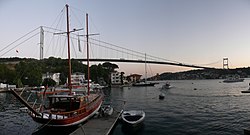

Maritime
[edit]The Bosporus is traversed by numerous passenger and vehicular ferries daily, as well as by recreational and fishing boats ranging from dinghies to yachts owned by both public and private entities.
The Strait also serves a significant amount of international commercial shipping traffic in the form offreightersandtankers.Between its northern limits atRumeli FeneriandAnadolu Feneriand its southern ones atAhırkapı FeneriandKadıköy İnciburnu Feneri,there are numerous dangerous points for large-scale maritime traffic that require sharp turns and management of visual obstructions. Famously, the stretch betweenKandilli PointandAşiyanrequires a 45-degree course alteration in a location where the currents can reach 7 to 8 knots (3.6 to 4.1 m/s). To the south, atYeniköy,the necessary course alteration is 80 degrees. Compounding these difficult changes in trajectory, the rear and forward sight lines atKandilliandYeniköyare also completely blocked prior to and during the course alteration, making it impossible for ships approaching from the opposite direction to see around the bends. The risks posed by this geography are further multiplied by the heavy ferry traffic across the Strait, linking the European and Asian sides of the city. As such, all the dangers and obstacles characteristic of narrow waterways are present and acute in this vital sea lane.
In 2011, the Turkish Government started to discuss creating a man-made canal roughly 80 kilometres (50 mi) long that would run north–south throughthe western edges of Istanbul Provinceas a second route from the Black Sea to the Marmara. It was suggested that this would reduce the risk from shipping to the Bosporus.[34][35]The controverislalKanal İstanbulproject continues to be debated.[37][38][39]
In 2022 the dues levied by Turkey for freight ships increased 500% to US$4 per ton, the first change since 1983.[40]
The Bosporus is fairly deep and there is no definite limit on the depth and length of a ship, but ships over 150 metres long or 10 metres deep must pre-book their passage. Those over 300 metres long must follow a special clearance procedure. There is an air draft limit of 57 metres.[41][42]
Land bridges
[edit]Twosuspension bridgesand acable-stayed bridgecross the Bosporus. The first of these, the 1,074 m (3,524 ft) long15th July Martyrs Bridgewas completed in 1973 when it was called the Bosporus Bridge. The second, namedFatih Sultan Mehmet (Bosporus II) Bridge,is 1,090 m (3,576 ft) long, and was completed in 1988 about 5 km (3 mi) north of the first bridge. The first Bosporus Bridge forms part of theO1 Motorway,while the Fatih Sultan Mehmet Bridge forms part of theTrans-European Motorway.The third and most recent bridge, theYavuz Sultan Selim Bridge,is 2,164 m (7,100 ft) long and was completed in 2016.[43][44]It is located near the northern end of the Bosporus, between the villages ofGaripçeon the European side andPoyrazköyon the Asian side,[45]as part of the "Northern Marmara Motorway",integrated into the existing Black Sea Coastal Highway, and allowing transit traffic to bypass city traffic.[43][44]
| Name | Opening date | Design | Total length | Width | Height | Longest span | Clearance below | Lanes |
|---|---|---|---|---|---|---|---|---|
| 15 July Martyrs Bridge | 30 October 1973 | Suspension bridge | 1,560 m (5,120 ft) | 33.4 m (110 ft) | 165 m (541 ft) | 1,074 m (3,524 ft) | 64 m (210 ft) | 6 lanes ofMotorway O1 |
| Fatih Sultan Mehmet Bridge | 3 July 1988 | Suspension bridge | 1,510 m (4,950 ft) | 39 m (128 ft) | 105 m (344 ft) | 1,090 m (3,580 ft) | 64 m (210 ft) | 8 lanes ofMotorway O2 |
| Yavuz Sultan Selim Bridge | 26 August 2016 | Hybrid cable-stayed, suspension bridge | 2,164 m (7,100 ft) | 58.4 m (192 ft) | 322 m (1,056 ft) | 1,408 m (4,619 ft) | 73 m (240 ft) | 8 lanes ofMotorway O7and 1 double-track railway |
Submarine
[edit]TheMarmarayproject, featuring a 13.7 km (8.5 mi) long undersearailwaytunnel,opened on 29 October 2013.[46]Approximately 1,400 m (4,593 ft) of the tunnel runs under the strait, at a depth of about 55 m (180 ft).
An underseawater supply tunnelwith a length of 5,551 m (18,212 ft),[47]named theBosporus Water Tunnel,was constructed in 2012 to transfer water from the Melen Creek inDüzce Province(to the east of the Bosporus strait, in northwesternAnatolia) to the European side of Istanbul, a distance of 185 km (115 mi).[47][48]
TheEurasia Tunnelis a 5.4 km (3.4 mi) underseahighwaytunnel designed for vehicular traffic betweenKazlıçeşmeon the European side of Istanbul andGöztepeon the Asian side. Construction began in February 2011, and the tunnel opened on 20 December 2016.[49]
Up to four submarine fibre optics lines (MedNautilusand possibly others) approach Istanbul, coming from the Mediterranean through the Dardanelles.[50][51]
Strategic importance
[edit]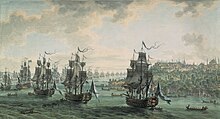
The Bosporus is the only way forBulgaria,Georgia,Romania,Russia(south-western part) andUkraineto reach theMediterranean Seaand other seas. Thus sovereignty over the straits is an important issue for these countries, as well asTurkey,the state the Bosporus actually flows through.
Turkey does not receive tolls from ships passing through the strait. Turkey's military has broad powers in accordance with the terms of theMontreux Convention.As of 2021, the Bosporus Command is located on the shores of the Bosporus and the military ships connected to the Command are anchored in the Bosporus waters.
Located on a peninsula at the intersection of the Black Sea, the Bosporus and the Marmara Sea, Istanbul has historically been one of the most protected and hardest-to-conquer cities from Roman times to the Ottoman Empire. Divided by the Bosporus, it is one of very few intercontinental cities in the world.
Sightseeing
[edit]The Bosporus has 620waterfront houses (yalı)built during theOttomanperiod along the Strait's European and Asian shorelines. Ottoman palaces such as theTopkapı Palace,Dolmabahçe Palace,Yıldız Palace,Çırağan Palace,Feriye Palaces,Beylerbeyi Palace,Küçüksu Palace,Ihlamur Palace,Hatice Sultan PalaceandAdile Sultan Palacealso stand on or near its shores. Other buildings and landmarks on the Bosporus include theKılıçEgyptian Consulate atBebek,Bebek Mosque,Boğaziçi University,Robert College,Rumeli Castle(RumelihisarI),Borusan Museum of Contemporary Art,Sakıp Sabancı Museum,Sadberk Hanım Museum,Üsküdar Mihrimah Sultan Mosque,Şemsipaşa Mosque,Maiden's Tower(Kızkulesi),Beylerbeyi Mosque,Anadolu Castle(Anadoluhisarı),Kuleli Military High School,Adile Sultan Palace,Küçüksu Pavilion,Khedive's Villa,Beykoz Mecidiye PavilionandYoros Castle(Anadaolu Kavağı).

Most of thepublic ferriesthat traverse the Strait leave fromEminönüon thehistoric peninsulaof Istanbul and travel as far asAnadolu Kavağınear theBlack Sea.On the way they call briefly at points on both the European and Asian shores. Private ferries, also leaving from Eminönü, travel only as far as one of the first two Bosporus bridges. Ferries from Eminönü also travel as far as Rumeli Kavaği, stopping only at points on the European shore, while other ferries from Üsküdar travel as far as Anadolu Kavağı, stopping only at points on the Asian shore. Frequent public ferries from Eminõnü,Karaköy,Beşiktaş,KadıköyandUsküdaroffer short hops from one side of the Bosporus to the other throughout the day.[52]
Catamaransea busesoffer high-speed commuter services between the European and Asian shores of the Bosporus, but they stop at fewerportsandpiersin comparison to the public ferries. Both the public ferries and the sea buses also provide commuter services between the Bosporus and thePrince Islandsin theSea of Marmara.
Tourist cruises are available from various points along the Bosporus, includingOrtaköy.The prices vary considerably, and some feature music and dining.
Architecture
[edit]
The manyyalı(waterside mansions) which were constructed along the shores of the Bosporus during the Ottoman period have long been synonymous with the Strait. Those that still preserve their original form are among the most expensive real estate in Turkey although many have been lost to time, weather and 'accidental' fires. The oldestyalıon the European shore is the Şerifler Yalı atEmirganwhich was built in the 18th century and belonged for a while to the Şerifs, the hereditary rulers ofMecca.It is still in good condition unlike the oldestyalıon the Asian side which is the Köprülü Amcazade Hüseyin Paşa Yalı atAnadolu Hisarı,built in 1698. Only the central section of thisyalısurvives and it has been behind hoardings promising restoration since 2009.[53]
Most of theyalısoriginally sat right on the water's edge and came with private docks and ports where boats (caiques) could be stored. On the Anatolian shore some yalıs are still right beside the water but on the European shore most now stand back behind a coast road built on reclaimed land.[citation needed]

The originalyalısusually had two main sections: theselamlıkwhich was the public area and the part of the house used by the men, and theharemlikwhich was the private part of the house reserved for women and the family. These were the luxurious dwellings of the wealthy and some came with their own privatehamams(Turkish baths).[citation needed]
Egyptian legacy
[edit]During the late 19th and early 20th centuries, the Egyptian royal family took a great liking to the Bosporus and often spent their summers on its shores. They left behind a legacy of fine buildings on or overlooking its shores, including the building at Bebek that now houses the Egyptian Consulate and theKhedive's Villa(Hıdiv Kasrı) high on the hill aboveÇubuklu.[54]
See also
[edit]- Black Sea trade and economy
- Great Istanbul Tunnel,a proposed three-level road-rail undersea tunnel
- Istanbul Canal
- List of maritime incidents in the Turkish Straits
- Public transport in Istanbul
- Rail transport in Turkey
- Eastern Bosphorus
Notes
[edit]- ^abThe spellingBosporusis listed first or exclusively in all major British and American dictionaries (e.g.Lexico,[1]Collins English Dictionary,[2]Longman Dictionary of Contemporary English,[3]Merriam-Webster,American Heritage Dictionary,[4]andRandom House) as well as theEncyclopædia Britannicaand theColumbia Encyclopedia.[5]TheAmerican Heritage Dictionary's online version has only this spelling and its search function does not find anything for the spellingBosphorus.TheColumbia Encyclopediaspecifies that the pronunciation of the alternative spellingphis also/p/,but dictionaries also list the pronunciation/f/for this spelling.
- ^There is a certain (Oxonian) tradition of equating the name "Oxford" with "Bosporus", see e.g. Wolstenholme Parr (1820),Memoir on the propriety of the word Oxford,esp. p. 18.[6]
References
[edit]- ^"Bosporus".Lexico.Oxford University Press. Archived fromthe originalon 29 July 2020.
- ^"Bosporus".Collins English Dictionary.HarperCollins.
- ^"Bosporus".Longman Dictionary of Contemporary English.Pearson.
- ^"Bosporus".American Heritage Dictionary of the English Language.HarperCollins.
- ^"Bosporus".Columbia Encyclopedia.Columbia University Press.
- ^Parr, Wolstenholme (1820).Memoir on the propriety of the word Oxford, as applied to a seminary of learning; read to the Instituto of Padoua, in the month of July last.Liverpool: William Grapel. p. 18.OCLC47642720.
- ^Liddell, Henry George; Scott, Robert (1940)."Βόσπορος".A Greek–English Lexicon.Oxford: Clarendon Press – viaPerseus Digital Library.
- ^Sickler, Friedrich (1824).Handbuch der alten Geographie für Gymnasien und zum Selbstunterricht(in German). Kassel: J. J. Bonné. p.551.
Die ihr entgegenstehende Landspitze hieß auchBousoderDamalis,mit einer ehernen coloss. Bildsäule einerKuh;aber hier war es auch, wo der Athen. Chares seiner Frau, derDamalis,ein Grabmal errichten ließ so dass die größere Wahrscheinlichkeit dafür ist, daß wenigstens diese Landspitze eher von derFrau Damalisals von derPrinzessin Joihren Namen erhalten habe.
- ^Lewis, Charlton T.; Short, Charles (1879)."Bosporus".A Latin Dictionary.Oxford: Clarendon Press – viaPerseus Digital Library.
- ^Müller, Carl (1861).Geographi graeci minores(in Latin). Paris: Didot. p. 7.
Herodotus (4, 85) nominat Bosporum Calchedoniæ (τῆς Καλχηδονίς τὸν Βόσπορον); Strabo, os Byzantiacum (p. 125στόμα Βυζαντιακόν,p. 318στόμα τὸ κατὰ Βυζάντιον); Joannes Tzetzes (Chil. 1, 886) appellat Bosporum Damaliten (τὸν Δαμαλίτην Βόσπορον) sua ætate nuncupatum vulgo Prosphorium.
- ^Bischoff, Friedrich Heinrich Theodor (1829).Verleichendes wörterbuch der alten, mittleren und neuen geographie(in German). Gotha: Becker. pp. 195–196.
- ^Tonguç & Yale 2010,p. 421.
- ^fanatik (27 July 2022)."Galatasaray Adası hizmete açıldı".Fanatik.Retrieved5 October2022.
- ^Aksu, A.E.; Hiscott, R.N. (April 2022)."Persistent Holocene outflow from the Black Sea to the eastern Mediterranean Sea still contradicts the Noah's Flood Hypothesis: A review of 1997–2021 evidence and a regional paleoceanographic synthesis for the latest Pleistocene–Holocene".Earth-Science Reviews.227:103960.doi:10.1016/j.earscirev.2022.103960.ISSN0012-8252.
- ^"Türk Boğazları ve Marmara Denizi'nin Coğrafi Konumu-İstanbul Boğazı"(in Turkish). Directorate-General of Maritime Affairs of Turkey. Archived fromthe originalon 8 October 2011.Retrieved18 September2010.
- ^Gregg, Michael C.; Özsoy, Emin (7 March 2002)."Flow, water mass changes, and hydraulics in the Bosphorus".Journal of Geophysical Research.107(C3): 3016.Bibcode:2002JGRC..107.3016G.doi:10.1029/2000JC000485.
- ^abc"Leeds Researchers Study Undersea Rivers with a Yellow Submarine"(Press release). University of Leeds. 2 August 2010. Archived fromthe originalon 3 August 2010.Retrieved22 June2018.
- ^"Robotic sub records flow of undersea river".Futurity.2 August 2010. Archived fromthe originalon 25 April 2013.Retrieved24 July2013.
- ^Di Iorio, Daniela; Yüce, Hüseyin (15 February 1999)."Observations of Mediterranean flow into the Black Sea".Journal of Geophysical Research.104(C2): 3091–3108.Bibcode:1999JGR...104.3091D.doi:10.1029/1998JC900023.
- ^Lericolais, G.; Le Drezen, E.; Nouzé, H.; Gillet, H.; Ergun, M.; Cifci, G.; Avci, M.; Dondurur, D.; Okay, S. (2002)."Recent canyon heads evidenced at the Bosporus outlet".AGU Fall Meeting Suppl.Eos: Transactions of the American Geophysical Union.Vol. 83, no. 47. Abstract PP71B-0409.
- ^Flood, Roger D.; Hiscott, Richard N.; Aksu, Ali E. (9 March 2009). "Morphology and evolution of an anastomosed channel network where saline underflow enters the Black Sea".Sedimentology.56(3): 807–839.Bibcode:2009Sedim..56..807F.doi:10.1111/j.1365-3091.2008.00998.x.S2CID128884071.
- ^"Ukrainian grain to pass through Bosphorus on Tuesday under landmark deal".Reuters.1 August 2022.Retrieved4 October2022.
- ^Donald John Cochrane Welsh Murray (13 May 2010)."Darius at the Bosporus".
- ^Herodotus (1859).The History of Herodotus: a new English version, Volume 3.Translated by George Rawlinson; Sir Henry Creswicke Rawlinson; Sir John Gardner Wilkinson. London: John Murray. p.77.
- ^Öztürk 2011,pp. 28–32.
- ^"The Bosphorus, with the Castles of Europe & Asia. 1846 — Allom, Thomas".Collections.Victoria and Albert Museum. 2007.
- ^Metz 1995,pp.22–23
- ^Metz 1995,pp.23, 25
- ^Rozakis, Christos L.; Stagos, Petros N. (1987).The Turkish Straits.Martinus Nijhoff Publishers. pp. 24–25.ISBN90-247-3464-9.
- ^Tonguç & Yale 2010,pp. 455, 460, 463.
- ^Torbakov, Igor (10 January 2003)."The Turkish Factor in the Geopolitics of the Post-Soviet Space".E-Notes.Foreign Policy Research Institute. Archived fromthe originalon 31 July 2010.Retrieved8 June2010.
- ^Cutler, Robert M. (28 March 1999)."[Russian and] Soviet Relations with Greece and Turkey: A Systems Perspective".Retrieved8 June2010.
- ^Bulaç, Ali (4 May 2009)."Against who and where are we going to stand?".Today's Zaman.Archived fromthe originalon 4 May 2009.Retrieved8 June2010.
- ^ab"Turkey to build Bosphorus bypass".New Civil Engineer.20 April 2011.Retrieved2 December2014.
- ^abMarfeldt, Birgitte (29 April 2011)."Startskud for gigantisk kanal gennem Tyrkiet".Ingeniøren(in Danish).Retrieved2 December2014.
- ^"Route of Canal Istanbul | Kanal İstanbul".kanalistanbul.gov.tr.Retrieved4 October2022.
- ^"İstanbul Canal project to open debate on Montreux Convention".Today's Zaman.8 October 2010. Archived fromthe originalon 30 April 2011.
- ^"Turkey debates whether international treaty is obstacle to plan to bypass the Bosporus".The Washington Post.29 April 2011. Archived fromthe originalon 11 December 2018.
- ^"Turkey's Ambitious Infrastructure Projects".Worldview.Stratfor.16 May 2013.Retrieved16 May2013.
- ^"Five Fold Increase of Transit Fees for Bosphorus & Dardanelles".Retrieved14 December2022.
- ^Bosphorus (Istanbul) Strait(2014 North Maritime)
- ^Maritime Traffic Regulations for the Turkish Straits and the Marmara Region, entered into force on 1 July 1994(United Nations)
- ^ab"3rd Bosphorus bridge opening ceremony".TRT World.25 August 2016. Archived fromthe originalon 28 August 2016.
- ^ab"Istanbul's mega project Yavuz Sultan Selim Bridge to open in large ceremony".Daily Sabah.25 August 2016. Archived fromthe originalon 26 October 2016.
- ^"Turkey Unveils Route for Istanbul's Third Bridge".Anatolian Agency.29 April 2010. Archived fromthe originalon 19 June 2010.
- ^"Turkey's Bosporus tunnel to open sub-sea Asia link".BBC News.29 October 2013.
- ^ab"Melen hattı Boğaz'ı geçti".CNN Türk(in Turkish). 21 May 2012.
- ^Nayır, Mehmet (19 May 2012)."Melen Boğaz'ı geçiyor".SabahEkonomi(in Turkish).Retrieved11 June2012.
- ^"Eurasia Tunnel Project"(PDF).Unicredit - Yapı Merkezi, SK EC Joint Venture. Archived fromthe original(PDF)on 4 March 2016.Retrieved13 April2014.
- ^Yüce, Gülnazi (7–8 June 2016).Submarine Cable Projects (2-03)(PDF).First South East European Regional CIGRÉ Conference. Portorož, Slovenia. Archived fromthe original(PDF)on 9 April 2018.Retrieved8 April2018.
- ^"Submarine Cable Map 2017".TeleGeography.Archivedfrom the original on 28 September 2017.Retrieved9 April2018.
- ^"Şehir Hatları A.Ş. ®".sehirhatlari.istanbul.Retrieved5 October2022.
- ^Tonguç & Yale 2010,pp. 442, 544.
- ^From the Shores of the Nile to the Bosphorus: Traces of Kavalalı Mehmed Ali Pasha Dynasty in Istanbul(in English and Turkish) (1st ed.). Istanbul: Istanbul Arıştırmaları Enstitüsü. 2011.ISBN9789759123956.
Sources
[edit]- Metz, Helen Chapin,ed. (1995).Turkey: a country study.Area handbook series. Washington, D.C.: Federal Research Division, Library of Congress.ISBN0-8444-0864-6.
- Öztürk, Özhan(2011).Pontus: Antikçağ'dan Günümüze Karadeniz'in Etnik ve Siyasi Tarihi(in Turkish). Ankara: Genesis Kitap.ISBN978-605-5410-17-9.
- Tonguç, Saffet Emre; Yale, Pat (2010).Istanbul The Ultimate Guide(1st ed.). Istanbul: Boyutl.ISBN9789752307346.
External links
[edit]- ..1914.



